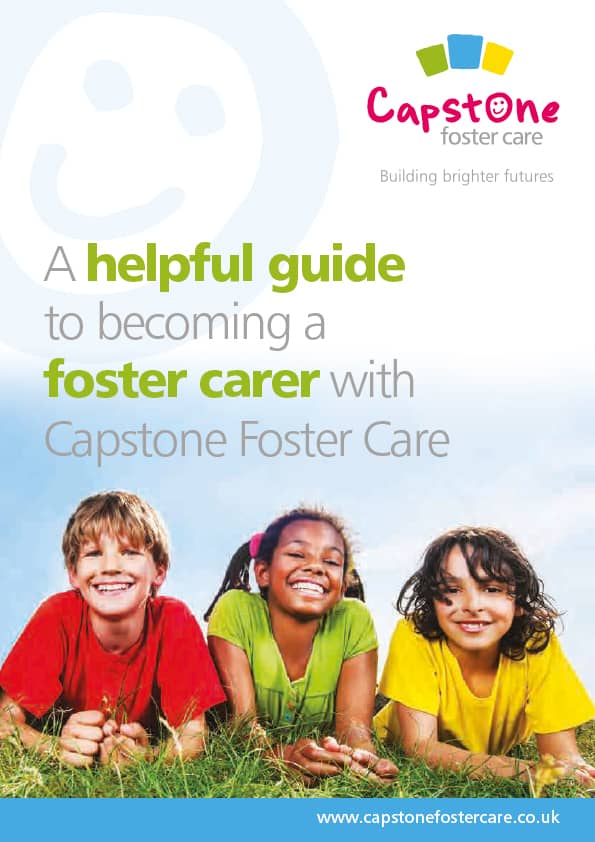


Fostering a disabled child
The role of an independent fostering agency
Can I choose who I foster?
How to foster
What are the benefits of fostering with an independent fostering agency?
What happens when a child is taken into care?
Fostering process: what happens on an initial home visit?
Can you foster if you have mental health issues?
Fostering with local authority vs independent agency
Interview: Life as a foster parent during the pandemic
Becoming A Foster Carer
Benefits of becoming a foster parent
What is a Care Leaver?
What is a Foster Carer?
What is Foster Care?
Do I become a Foster Carer?
Fostering Regulations
How much do Foster Parents get paid?
How to Foster a Child
How long does it take to become a Foster Carer?
How to foster – everything you ever wanted to know
Facts about Foster Care
What are the Foster Care requirements?
Foster Care Handbook
Foster Carer Job Description
Changing IFA - Transferring to Capstone
Fostering Definition
Foster Care Statistics
Fostering Assessment
Fostering Outcomes
Fostering Stories
Fostering Children UK
Children needing Fostering
8 reasons why a child may be taken into care
Fostering as a Career
Looked after Children
Top transferable job skills to become a foster carer
Fostering as a same sex couple
Fostering while renting
Can I foster if...?
Mythbusting the top 10 Foster Care Myths
Can I foster if I am disabled?
LGBT Fostering Mythbusting
Can I foster if I have pets?
Can I Foster A Child?
Can you Foster and Work?
Can you Foster with a Criminal Record
Fostering as a Single Parent
LGBT Family and Foster Care
Fostering across Cultures
Muslim Fostering
Christian Foster Care
Sikh
Empty Nest Syndrome and Foster Care
10 things you can do when your Children fly the nest
Can I Foster?
Fostering Babies - Myths
Focusing on Parent & Child Fostering
Fostering Siblings
Fostering Teenagers
Fostering Teenagers - Breaking down the Myths
Fostering Unaccompanied and Asylum Seeking Children
Mother and Baby Foster Placements
Private Fostering
Therapeutic Fostering - Multi-disciplinary Assessment Treatment & Therapy Service (MATTS)
Young Children Fostering Placements
Difference between short and long-term fostering
How to prepare a child for becoming a care leaver
Children who foster: impact of fostering on birth children
How to prepare your home for a foster child
10 tips for foster children’s education
How to prepare your foster child for secondary school
Tips for coping when foster placements end
Tips for foster parents during Coronavirus
What happens if foster parents get divorced?
5 ways to manage Mother’s Day with foster children
Tips for managing foster children’s bedtime routines
How to handle foster child bullying
Fostering allowances and the gender pay gap
Tips for keeping foster children safe online
How to adopt from Foster Care
5 ways to manage Father’s Day with foster children
8 most common fostering challenges
Supporting foster children’s contact with birth families
How to deal with empty nest syndrome
How to recognise signs of depression in foster children
Can you take a foster child on holiday?
Tips and advice on fostering with a disability
10 tips on connecting with your Foster Child
Fostering versus Adoption - What's the difference?
How Fostering can change a future
How to adopt from Foster Care
How to encourage children to read in Foster Care
How to prepare a Foster Child's bedroom
Online grooming - unwanted contact and how to identify it
Reading and storytelling with Babies and young Children
Supporting Children's Learning
Technology and Internet Safety advice
The 20 most recommended books Foster Carers and young people should read
The impact of early childhood traumas on adolescence and adulthood
Tips for coping with attachment disorders in Foster Children
Tips for supporting reunification in Foster Care
Together for a better Internet - Web Safety for Foster Children
What is sexual abuse and sexual violence
Foster Child behaviour management strategies
Foster Parent Advice: What to expect in your first year of fostering
Capstone's twelve tips at Christmas
10 celebrities who grew up in Foster Care
Celebrating our Children and Young People
Could Millenials be the solution to the Foster Care crisis?
Do you work in Emergency Services?
Form F Assessor and Assessment Training
Foster Care Fortnight
Improving Children's Welfare - Celebrating Universal Children's Day
It's time to talk about Mental Health and Foster Care
New Year - New Career - Become a Foster Carer
Promoting the rights and wellbeing of persons with Disabilities
Refugee Week
Young people and Mental Health in a changing world
Young People Charities
Storytelling is considered to be the first way of communicating life experiences and the creative imagination. Since the beginning of time, everything that humans learned was shared in oral tradition. Storytelling predates the written language. Indeed, without stories we would have no record of the past upon which to build a future.
Consider how important that storytelling is in sharing life experiences with a baby or a young child and how important it is to awaken a child’s creative imagination. The Society For Storytelling celebrates the value of storytelling with National Storytelling Week. In 2019, National Storytelling Week runs from 26th January to the 2nd February. The event is celebrated in storytelling clubs, theatres, museums, schools, hospitals, spoken word venues, and care homes.
The Society For Storytelling refers to the magic that occurs between the breath of the teller and the ear of the listener. The magic is in the power of stories and their abilities to transform the moment into a world where memories are evoked, and the imagination is set free. For a child, stories broaden their world and ignite their imagination.
It’s never too early to start reading to a baby. Hold your baby snuggled in your lap and read. By the time a baby is three to six month old, he or she begins to respond to pictures of faces, shapes, and colours. Read books with pictures and textures because at this age, the baby will become involved in touching the pictures. Even before three months, reading to your baby is a good idea. It involves cuddling and the sound of your voice as well as providing images for the baby’s ability to acquire the skill of focusing their eyes.
The effects of story-telling on the development of children is powerful. For some children a bedtime story is part of a daily ritual where the child not only learns how to traverse the world of imagination but also has a quiet time where the parent is close, sharing that special time with the child. It is a bonding moment where the parent and child take their journey together into the world of the story.
However not every child is blessed with stories as part of their everyday life. National Story Telling Week is a perfect time to delve into the oral tradition of storytelling. Stories are one of the finest gifts a foster parent can give to a child in care. For any child, the time spent with a parent reading or telling a story provides brain development and a way to learn language and emotions. For a child in care, it gives them bonding time with your comforting voice providing an entertaining story.
The stories don’t always need to come from the reading of books. Singing songs and sharing rhymes or telling old tales from the child’s culture are merely different forms of storytelling. Reading to babies or telling them stories is important even before they understand the words. Babies and young children respond to stories and songs with good rhyme, rhythm and repetition. It’s cadence over words at this stage.
Reading is one of the most important daily routines that you and your child should have. Bedtime is a typical storytelling time because it provides a gentle way to end the child’s day, but storytelling can happen any time of the day. Other times that naturally lend themselves to storytelling include bath time or potty time. Stories make travelling more appealing to a child. Whether you are on a train or bus or in a car, reading stories or telling stories passes the time and staves off the child’s boredom.
If you make it a habit to carry a book with you, you will always be ready for story time. When you make it a priority to read a book or tell a story from your own memory or imagination, you are giving the child so much more than the time you spend in sharing the storytelling activity.
The more words a child hears, the better the little one will be able to develop language skills as well as literacy skills. When you share a story, you are making the child’s world bigger and using more and different words that you might use in the routine of the day. Words awaken the child’s curiosity. The more stories they hear, the more questions they have. The more questions they have, the more their imagination will grow.
Stories expand a child’s life as they hear about more people doing different things. This is a wonderful way for a child to learn the difference between what is real and what is make-believe. When stories are valued, children learn to value their own make-believe worlds where their imaginations can take them to magical places. They are also able to differentiate between the reality of what happens and what is fantasy.
Reading to a child is a way for the child to understand change and face new, possibly frightening, events. When they hear stories, they get a glimpse of emotions that they may not have yet experienced. Stories validate emotions and responses to emotions in a safe environment where they can avoid being overwhelmed.
Storytelling from books is a learning experience beyond the story. The first time a baby sees a book, they need to learn what it is. When you hold a book and turn the pages, even though the little one cannot read or understand the relationship between the symbols on the page and the words you read to them, they learn that there are stories inside those pages.
When your child requests the same story night after night, you have the opportunity to demonstrate that a certain book with a certain cover has a specific story in it and the story is repeatable exactly the same way every time.
Whether you use reading as a way of helping with the child’s language and literacy development or use it for the pleasure of reading, you can add singing songs and repeating nonsense rhymes together to the mix.
Young children often like to hear the same story over and over again. It can be fun and creative to take one of the child’s favourite stories and together you use the pictures in the book as a guide while you and the young child create your own story. If the child is familiar with the story because he or she has heard it several times or more, it can be imagination-expanding to help them make up a different story with some of the familiar elements. Get the child involved in telling a different story using the same pictures as in the story that he or she has already heard.
If you want to go beyond books and still find ways to share letters, words and pictures, you can share other sources of words. Something as simple as picking up a can of soup and reading the label can be informative. It is a way for the child to learn that words can make an entertaining story and provide useful information.
While they cannot read, they can recognise shapes. Knowing that different shapes on the cans means that there are different kinds of soup in the cans is quite a lesson to learn. Knowing which is tomato soup and which is mushroom soup can give a young child a feeling of pride in knowing more about how they can have a say in their life. The same power over knowing more about their daily lives can also be learned through recognising words in a restaurant menu, posters in a shop, or signs on the road.
As a foster carer, a bedtime story creates a new and special connection between you and the child in care. It is a time when the child can be transported into a new world, the world in the story, and be given a period of time with you where they can have the story in their minds, allowing for their imagination to relax while they can be with you in a one-on-one moment.
The value of a good book or a good story has been shown to have a positive effect on a child’s sense of imagination and their ability to explore their feelings and thoughts. Books are non-confrontational. They are a door into a world where the child can be anything or anyone he or she wants to be. A story can open up a dialogue that might not otherwise have existed.
To help in getting started with a regular routine of reading books with babies and young children, here are some helpful tips:
If you need help in finding more, and more age-appropriate books, bookstores and libraries have books in all age categories. As a matter of fact, they have so many books, it can be overwhelming to figure out where to start. There are some helpful hints when it comes to choosing books for babies and toddlers. The biggest hint is that children at this age like a story with good rhyme, rhythm and repetition. This is good because it is through repetition and rhyme that children learn.
Younger children may have a shorter ability to listen to a story. Therefore, it is important to know when to stop reading. You will know when to watch for the signs that the story has gone beyond the child’s attention span. It is not necessary to finish the book. You can stop the storytelling any time that it seems that the child is restless with the story. Sometimes, perhaps the child simply wants to stop with a certain part of the story and think about that part of the story. Stopping before the story is done is a good way for the child to learn that it is all right to absorb a book over several sessions.
When you read to a baby, read slowly and spend time with each page after you have read the words on that page. The baby should be sitting so that the page is close enough for him or her to see the pictures and the shape of the words. Let the baby savour the page and when you turn the page, the baby learns how books work.
When the new page appears, take time before you read to explore the new page together and point out things that might have already appeared in the book and point out new things that showed up on this page. Use different tones of voice as you read. This allows baby to hear different speech sounds, teaching the baby to make new sounds.
An older child, between a year and eighteen months, is ready to choose the book for you to read as well as hold the book while you read. Allowing the child to turn the pages is also beneficial, both in understanding what a book is and in feeling the happiness in being involved in the process of reading.
As they approach toddlerhood, babies are ready and often eager to help you read by filling in the words in the story. If you are reading a familiar book, you can pause and let the toddler fill in the words that he or she already knows. The toddler is, in essence, reading. When you pause to look at the pictures, ask the toddler to name what is seen in the pictures. Participating in making sound effects for the story is a shared activity and experience that you will both enjoy.
Celebrate National Storytelling Week. May sure that reading is an active part of your foster family life.
If you’ve got any questions or would like to find out more about fostering with Capstone, fill out the form below.
An experienced fostering advisor from your local area will then be in touch.

Start the conversation today. Our team of friendly advisors are on hand to answer any foster care questions you may have. We can offer you honest and practical advice that can help you decide if becoming a foster carer is the right path for you.


